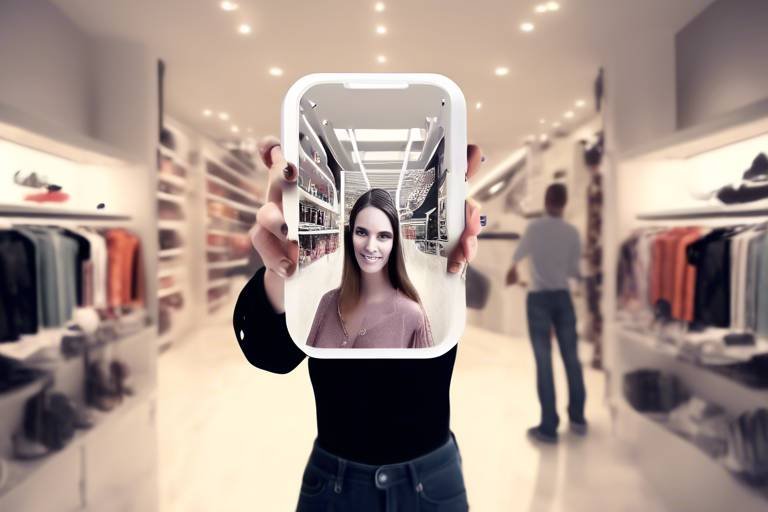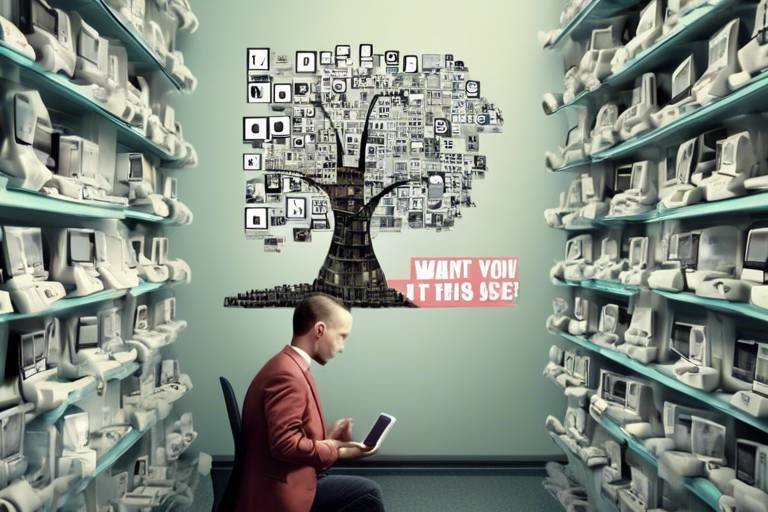The Impact of Virtual Reality on Therapeutic Practices
In recent years, virtual reality (VR) has emerged as a groundbreaking technology that is reshaping various fields, and therapeutic practices are no exception. Imagine stepping into a world where your fears can be faced head-on, where rehabilitation can feel more like a game than a chore, and where pain management can be achieved through immersive experiences. This is not science fiction; it's the reality of VR therapy. By creating immersive environments, VR offers patients a unique opportunity to engage with their treatment in ways that were previously unimaginable. From mental health to physical rehabilitation, the applications of VR are both diverse and impactful, enhancing patient experiences and outcomes.
One of the most exciting aspects of VR in therapy is its ability to provide a safe space for patients to confront their challenges. Whether it's a person grappling with anxiety or someone recovering from a traumatic event, VR can facilitate a therapeutic journey that feels both supportive and effective. As we delve deeper into the world of VR therapy, we will explore its applications, benefits, and the challenges that come with this innovative approach. The potential for VR to transform therapeutic practices is immense, and understanding its impact is crucial for both practitioners and patients alike.
As we navigate through this article, we will uncover how VR technology is not just a trend but a pivotal tool in enhancing therapeutic practices. By examining its applications in mental health, physical rehabilitation, and its future potential, we will illustrate how VR is changing the landscape of therapy. So, buckle up and get ready to explore the fascinating intersection of technology and healing!

Understanding Virtual Reality in Therapy
Virtual Reality (VR) is revolutionizing the way we approach therapy by immersing patients in a digital world that can simulate real-life scenarios. This technology is not just about gaming; it’s a powerful tool that enhances therapeutic practices across various disciplines. At its core, VR consists of a headset that provides a 360-degree view of a virtual environment, often combined with motion tracking sensors that allow users to interact with the space around them. Imagine stepping into a serene forest or facing a fearsome spider—all without leaving your therapist's office. This immersive experience is what makes VR particularly effective in therapeutic settings.
VR therapy can be broken down into several key components:
- Immersion: The feeling of being physically present in a non-physical world.
- Interactivity: The ability to manipulate elements within the virtual environment.
- Realism: High-quality graphics and sound that enhance the experience.
In therapeutic settings, VR can be utilized in various ways. For instance, it can provide a safe space for patients to confront their fears, practice social skills, or engage in mindfulness exercises. By allowing patients to face their challenges in a controlled environment, therapists can guide them through the process, helping them develop coping strategies and resilience. This approach is particularly beneficial for individuals who may find traditional therapy intimidating or overwhelming.
Moreover, as technology continues to advance, the potential applications of VR in therapy are expanding. From treating anxiety disorders to aiding in physical rehabilitation, VR is proving to be a versatile tool in the mental health and physical therapy arenas. The ability to customize experiences based on individual needs means that therapy can be more personalized and effective. As we explore the various applications of VR in therapy, it becomes clear that this technology is not just a passing trend; it’s a transformative force that is reshaping how we think about treatment.

Applications of VR in Mental Health
Virtual reality (VR) is revolutionizing the way we approach mental health treatment. By creating immersive environments, VR allows therapists to simulate real-world scenarios that can be crucial for effective therapy. Imagine being able to confront your fears or manage anxiety without leaving the safety of a therapist's office; that's the magic of VR! This technology is not just a gimmick; it's a powerful tool that enhances traditional therapeutic practices.
One of the most exciting applications of VR in mental health is its role in exposure therapy. This technique, often used to treat phobias and PTSD, involves gradually exposing patients to the source of their anxiety in a controlled setting. With VR, patients can face their fears—be it heights, spiders, or crowded places—without the real-world consequences. This controlled exposure helps in desensitizing patients, allowing them to develop healthier coping mechanisms.
For instance, consider someone with a fear of flying. Through VR, they can experience a virtual flight, complete with realistic sounds and visuals, while being guided by a therapist. This approach not only prepares them for real-life situations but also significantly reduces their anxiety levels. It's like practicing for a big performance in a safe rehearsal space before stepping onto the main stage!
Another crucial area where VR shines is in anxiety management and stress relief. Imagine putting on a VR headset and being transported to a tranquil beach or a serene forest. These immersive experiences can promote relaxation, mindfulness, and emotional regulation. Patients can learn to manage their stress levels by engaging in guided meditation or breathing exercises within these calming virtual environments. The ability to escape to a peaceful setting, even for a short time, can make a world of difference in managing daily stressors.
Moreover, VR has shown promise in treating conditions like depression. By creating interactive experiences that encourage social engagement, VR can help combat feelings of isolation. For instance, virtual support groups allow individuals to connect with others facing similar challenges, fostering a sense of community and belonging. It's like having a friend by your side, even when you're miles apart!
However, it's essential to recognize that while VR offers exciting possibilities, it is not a standalone solution. It should be integrated into a comprehensive treatment plan tailored to individual needs. The collaboration between technology and traditional therapy can create a more holistic approach to mental health, enhancing patient outcomes and experiences.
As we continue to explore the applications of VR in mental health, it becomes clear that this technology is paving the way for innovative treatment options. With ongoing research and development, the potential for VR to transform therapeutic practices is immense. It's like opening a door to a new world of healing possibilities, where patients can embark on their journey to recovery with confidence and support.
- What is virtual reality therapy?
Virtual reality therapy uses immersive technology to create controlled environments for therapeutic purposes, helping patients confront fears, manage anxiety, and enhance overall mental well-being. - Is VR therapy effective?
Research has shown that VR therapy can be highly effective, particularly for conditions like phobias, PTSD, and anxiety disorders. Its immersive nature allows for controlled exposure and engagement. - Are there any side effects of VR therapy?
Some individuals may experience motion sickness or discomfort while using VR. It’s essential to consult with a healthcare professional to determine the suitability of VR therapy for each individual. - How accessible is VR therapy?
While VR technology is becoming more accessible, cost and availability can still be barriers. Many clinics are beginning to incorporate VR into their practices, but it may not be widely available everywhere yet.

Exposure Therapy Techniques
Exposure therapy is a powerful psychological treatment that helps individuals confront their fears and anxieties in a controlled and safe environment. With the advent of virtual reality (VR), these techniques have evolved to offer even more immersive and effective experiences. Imagine being able to face your fear of heights by virtually standing on the edge of a skyscraper, all while knowing you're safely in a therapist's office. This is the magic of VR in exposure therapy.
At its core, exposure therapy involves gradually exposing patients to the source of their fear, allowing them to build resilience and reduce anxiety over time. Traditional methods often relied on real-life exposure, which could be daunting and sometimes impractical. However, VR technology provides a unique solution by creating realistic simulations that can be tailored to each patient's specific fears. This customization is crucial, as it allows therapists to adjust the intensity and nature of the exposure based on the individual's progress and comfort level.
One of the most significant advantages of using VR in exposure therapy is the ability to control the environment. For instance, if a patient has a fear of flying, a therapist can simulate an airplane cabin experience, complete with sounds, sights, and even sensations. This controlled setting helps patients gradually desensitize to their fears without the overwhelming stress of real-life situations. The immersive nature of VR also enhances engagement, making the therapeutic process more enjoyable and impactful.
Furthermore, VR exposure therapy can be particularly beneficial for treating specific phobias. For example, patients with a fear of spiders can interact with lifelike virtual arachnids in a safe space, allowing them to confront their fears head-on. Studies have shown that this approach can lead to significant reductions in anxiety and avoidance behaviors. The effectiveness of VR in treating phobias is not just anecdotal; research indicates that patients often experience lasting improvements in their symptoms.
In addition to phobias, VR is proving to be a valuable tool in addressing more complex conditions such as Post-Traumatic Stress Disorder (PTSD). By recreating traumatic scenarios in a controlled environment, patients can process their experiences and emotions with the guidance of a therapist. This therapeutic approach allows for a safe exploration of their trauma, enabling them to work through their feelings and develop coping strategies.
As we look to the future, the integration of VR into exposure therapy techniques holds great promise. The potential for enhanced patient outcomes is immense, and ongoing research will likely uncover even more innovative applications. As therapists continue to embrace this technology, we can expect to see a transformation in how we approach and treat anxiety-related disorders.
In conclusion, VR is revolutionizing exposure therapy by providing immersive experiences that allow patients to confront their fears in a safe and controlled manner. With its ability to enhance engagement and tailor experiences to individual needs, VR is paving the way for more effective therapeutic practices. As we continue to explore the possibilities of this technology, the future of mental health treatment looks brighter than ever.
- What is exposure therapy?
Exposure therapy is a psychological treatment that helps individuals confront their fears gradually in a controlled environment. - How does VR enhance exposure therapy?
VR creates realistic simulations that allow patients to face their fears without the risks associated with real-life exposure. - Can VR be used for all types of phobias?
While VR is effective for many phobias, its suitability depends on the individual and the specific fear being addressed. - Is VR exposure therapy safe?
Yes, VR exposure therapy is considered safe and is conducted under the supervision of trained professionals.

Phobias and VR
Phobias can often feel like an insurmountable wall, blocking individuals from experiencing life to its fullest. Imagine being terrified of heights, yet standing on a balcony on the 20th floor; the anxiety can be overwhelming. This is where Virtual Reality (VR) steps in as a revolutionary tool in therapeutic practices. By immersing patients in a controlled virtual environment, therapists can help them confront their fears in a safe space, gradually desensitizing them to the triggers of their phobias.
One of the most significant advantages of using VR for phobias is the ability to tailor experiences to individual needs. For instance, someone with a fear of flying can be placed in a simulated airplane setting, where they can experience takeoff, turbulence, and landing without ever leaving the ground. This exposure can be done in incremental stages, allowing the patient to acclimate to their fear at their own pace. The immersive nature of VR can create a sense of realism that traditional methods simply cannot replicate.
Consider the following common phobias that have shown promising results through VR therapy:
- Arachnophobia (fear of spiders): Patients can interact with virtual spiders, learning to manage their fear through gradual exposure.
- Acrophobia (fear of heights): VR can simulate high places, helping individuals confront their fear while remaining safely on the ground.
- Claustrophobia (fear of confined spaces): Patients can experience being in an elevator or a small room, allowing them to practice coping strategies.
Several studies have reported significant success rates in treating phobias through VR. For example, a recent study indicated that over 80% of participants with specific phobias experienced a marked reduction in anxiety levels after several VR sessions. This innovative approach not only equips patients with coping mechanisms but also empowers them to take control of their fears.
Moreover, VR therapy for phobias is not just about facing fears; it’s also about building resilience and confidence. Patients often report feeling a sense of accomplishment after each session, which can boost their overall self-esteem. The therapeutic journey becomes less about avoiding fears and more about embracing challenges, leading to profound personal growth.
However, while VR therapy offers exciting possibilities, it’s essential to have trained professionals guiding the process. Proper supervision ensures that patients are not overwhelmed and can safely navigate their experiences. As technology continues to advance, the potential for VR in treating phobias is bound to expand, making it an exciting field to watch in the coming years.
Q: How long does VR therapy for phobias typically take?
A: The duration varies based on the individual and the severity of the phobia. Generally, a series of sessions over a few weeks can lead to significant improvements.
Q: Is VR therapy safe?
A: Yes, when conducted under the supervision of a qualified therapist, VR therapy is considered safe. Therapists can control the environment and pace to ensure patient comfort.
Q: Can VR therapy be used for other mental health issues?
A: Absolutely! VR is being explored for various conditions, including anxiety disorders, PTSD, and social phobias, showing promising results across the board.

Post-Traumatic Stress Disorder (PTSD)
Post-Traumatic Stress Disorder, or PTSD, is a mental health condition that can occur after experiencing or witnessing a traumatic event. It’s like carrying a heavy backpack filled with memories that you just can't shake off. For many, the symptoms can be overwhelming, leading to flashbacks, nightmares, and severe anxiety. Traditional therapies have been effective, but the advent of Virtual Reality (VR) has introduced a groundbreaking approach to treatment that is changing lives.
VR therapy for PTSD allows patients to confront their traumatic memories in a safe and controlled environment. Imagine being able to face your fears without the real-world consequences—this is the essence of VR therapy. By immersing patients in virtual scenarios that mimic their trauma, therapists can help them process their experiences and gradually desensitize them to the triggers that provoke their anxiety.
One of the most significant advantages of VR in treating PTSD is the ability to tailor the experience to each patient. For instance, a veteran who has experienced combat may be placed in a virtual battlefield, where they can confront their memories while under the guidance of a trained therapist. This controlled exposure can help them to gradually reduce their anxiety and regain a sense of control over their lives.
Furthermore, research has shown that VR therapy can lead to significant improvements in PTSD symptoms. A study conducted by the Virtual Reality Medical Center found that patients who underwent VR exposure therapy experienced a reduction in PTSD symptoms by up to 60% after just a few sessions. This is a remarkable statistic that highlights the potential of VR as an effective treatment option.
However, it's important to note that this technology is not a one-size-fits-all solution. Each patient’s journey with PTSD is unique, and while VR can be a powerful tool, it works best when combined with traditional therapeutic approaches, such as cognitive-behavioral therapy (CBT) or medication. The integration of VR therapy into a comprehensive treatment plan can enhance the overall effectiveness, providing patients with multiple avenues for healing.
In conclusion, the use of VR in treating PTSD is a promising development in the field of mental health. By allowing patients to face their fears in a safe environment, VR therapy not only aids in symptom reduction but also empowers individuals to reclaim their lives. As technology continues to evolve, the possibilities for enhancing therapeutic practices through VR are boundless, offering hope to those who have long struggled with the burdens of trauma.
- What is PTSD? PTSD is a mental health condition triggered by experiencing or witnessing traumatic events.
- How does VR therapy work for PTSD? VR therapy immerses patients in controlled virtual environments that replicate their traumatic experiences, allowing them to confront and process their memories safely.
- Is VR therapy effective for everyone with PTSD? While many patients have benefited from VR therapy, it is most effective when used in conjunction with other therapeutic methods tailored to individual needs.

Anxiety and Stress Management
Anxiety and stress are like unwelcome guests that can crash the party of our lives, leaving us feeling overwhelmed and drained. But what if I told you that virtual reality (VR) is stepping in as a superhero in the realm of mental health? By immersing patients in calming environments, VR offers a unique escape that can significantly aid in anxiety reduction and stress management. Imagine being transported to a serene beach or a tranquil forest, all while sitting in a therapist's office. This is the magic of VR, and it’s changing the way we tackle anxiety.
One of the most exciting aspects of VR in anxiety management is its ability to create immersive relaxation techniques. These techniques are designed to promote mindfulness, allowing individuals to focus on the present moment rather than spiraling into a cycle of anxious thoughts. For instance, a patient might find themselves in a peaceful meadow, surrounded by gentle sounds of nature. This environment encourages deep breathing and relaxation, helping to lower heart rates and reduce stress levels.
Moreover, VR can be customized to fit the needs of the individual. Therapists can tailor experiences based on a patient's specific triggers or stressors. For example, if someone feels anxious about public speaking, a VR simulation can mimic a speaking engagement, allowing them to practice in a safe and controlled environment. This method not only helps in reducing anxiety but also builds confidence through repeated exposure.
Another fascinating application of VR in anxiety management is its role in promoting emotional regulation. Patients can learn to identify and manage their emotional responses to stressors in real-time. By experiencing virtual scenarios that provoke anxiety, they can develop coping strategies and techniques to handle similar situations in their everyday lives. This process is akin to training for a marathon; the more you practice, the stronger and more resilient you become.
As we delve deeper into the world of VR, it’s clear that its potential in anxiety and stress management is vast. However, it’s essential to recognize that VR is not a one-size-fits-all solution. Each individual's journey with anxiety is unique, and while VR can be a powerful tool, it should complement traditional therapeutic approaches rather than replace them. The integration of VR into therapy is like adding a new color to an artist's palette; it enhances the overall picture but doesn't overshadow the foundational elements.
In summary, virtual reality is revolutionizing how we approach anxiety and stress management. By providing immersive experiences that promote relaxation, emotional regulation, and exposure to triggers, VR is helping individuals reclaim their peace of mind. As technology continues to evolve, we can only anticipate even more innovative applications of VR in the mental health field, paving the way for a brighter, more balanced future.
- What is virtual reality therapy? - Virtual reality therapy uses immersive technology to create simulated environments for therapeutic purposes, helping patients confront fears, manage anxiety, and practice coping strategies.
- How effective is VR for anxiety management? - Research shows that VR can significantly reduce anxiety symptoms by providing controlled exposure to stressors and promoting relaxation techniques.
- Are there any side effects of VR therapy? - While generally safe, some users may experience motion sickness or discomfort during VR sessions. It's important to consult with a healthcare provider before starting VR therapy.
- Can VR therapy be used alongside traditional therapy? - Absolutely! VR therapy is often used as a complementary approach to traditional therapeutic methods, enhancing overall treatment outcomes.

VR in Physical Rehabilitation
Virtual Reality (VR) is revolutionizing the way we approach physical rehabilitation. Imagine stepping into a world where your therapy sessions are not just mundane exercises, but immersive experiences that transport you to different environments. This innovative technology engages patients in a way that traditional methods simply cannot. By creating interactive and stimulating scenarios, VR not only enhances motivation but also promotes better recovery outcomes.
One of the most significant advantages of VR in rehabilitation is its ability to provide real-time feedback. Patients can see their progress immediately, which can be incredibly encouraging. For instance, when a stroke survivor practices their motor skills in a virtual environment, they can visualize their movements and receive instant corrections. This immediate feedback loop is crucial because it helps patients understand their limitations and encourages them to push beyond them.
Furthermore, VR can be tailored to meet individual needs. Each patient's journey is unique, and VR allows therapists to customize exercises based on specific goals. For example, a patient recovering from a knee injury might engage in a virtual game that mimics walking on a beach, while another patient might navigate a virtual obstacle course to improve balance and coordination. This level of personalization not only makes therapy more enjoyable but also significantly boosts adherence to rehabilitation programs.
Another fascinating aspect of VR in rehabilitation is the concept of gamification. By incorporating game-like elements into therapy, patients are more likely to stay engaged and motivated. Imagine a patient who, instead of dreading their next session, looks forward to "playing" their way through a challenging virtual landscape. This approach not only makes the process fun but also encourages patients to push their limits, leading to enhanced recovery outcomes.
However, it's essential to acknowledge that while VR offers exciting possibilities, it is not without its challenges. Accessibility is a significant concern; not all rehabilitation centers have the resources to implement VR technology. Additionally, the cost of VR systems can be prohibitive for some patients. Despite these challenges, ongoing research and advancements in technology are paving the way for more accessible solutions in the future.
In summary, VR is transforming physical rehabilitation by making it more engaging, personalized, and effective. As we continue to explore the potential of this technology, it’s clear that VR is not just a passing trend but a vital tool that can significantly enhance the rehabilitation experience for countless patients.
- What types of injuries can VR help rehabilitate? VR can assist in rehabilitation for a variety of injuries, including stroke recovery, sports injuries, and post-surgical rehabilitation.
- Is VR therapy suitable for all patients? While VR can benefit many patients, it may not be suitable for those with certain medical conditions or severe mobility impairments. Always consult with a healthcare provider.
- How does gamification improve rehabilitation? Gamification increases motivation and engagement by turning therapy into a fun, interactive experience, leading to better adherence and outcomes.
- Are there any risks associated with VR therapy? Some patients may experience motion sickness or discomfort while using VR. It's essential to monitor patients closely and adjust the experience as needed.

Gamification in Rehab
Gamification in rehabilitation is revolutionizing the way patients engage with their recovery process. Imagine turning tedious exercises into exciting games that not only motivate but also enhance the overall experience of physical therapy. This innovative approach leverages the principles of game design—like points, levels, and rewards—to make rehabilitation more enjoyable and effective. By incorporating these elements, therapists can transform traditional rehabilitation into a dynamic environment where patients feel a sense of achievement and progress.
One of the primary benefits of gamification in rehab is its ability to increase patient adherence. When patients are actively engaged in a game-like setting, they are more likely to participate in their therapy sessions consistently. For instance, consider a stroke patient who might find repetitive exercises dull and frustrating. By integrating gamified elements, such as scoring systems or competitive challenges, the same exercises can become engaging. Patients might find themselves eager to "level up" or beat their previous scores, thus improving their motivation to practice regularly.
Moreover, gamification can provide immediate feedback, which is crucial for rehabilitation. Patients can track their progress in real-time, seeing how their skills improve with each session. This instant gratification can be a powerful motivator, as it allows individuals to visualize their journey toward recovery. For example, a patient working on balance exercises might see their scores increase as they successfully complete tasks, reinforcing their efforts and encouraging them to push further.
In addition to motivation and engagement, gamification fosters a sense of community among patients. Many VR rehabilitation programs include multiplayer features, allowing patients to compete or collaborate with others. This social aspect can alleviate feelings of isolation that often accompany long-term rehabilitation. Patients can share their achievements, cheer each other on, and even form friendships, creating a supportive network that enhances the healing process.
However, it's essential to recognize that while gamification offers numerous advantages, it should be implemented thoughtfully. Not all patients may respond positively to this approach, and it's crucial for therapists to tailor gamified experiences to individual needs and preferences. Some patients may prefer a more traditional approach, while others might thrive in a competitive environment. By understanding these differences, therapists can ensure that gamification enhances rather than detracts from the rehabilitation experience.
| Benefits of Gamification in Rehab | Examples |
|---|---|
| Increased Engagement | Interactive VR games that require physical movement |
| Improved Motivation | Reward systems for completing exercises |
| Immediate Feedback | Real-time performance tracking |
| Enhanced Social Interaction | Multiplayer challenges with peers |
As we look toward the future, the potential for gamification in rehabilitation seems limitless. With advancements in technology, we can expect even more immersive experiences that blend physical therapy with engaging game mechanics. This evolution not only promises to make rehabilitation more enjoyable but also to enhance recovery outcomes for patients. So, next time you think of rehab, picture a world where every exercise feels like a game, and every session is a step closer to a healthier, more active life!
- What is gamification in rehabilitation? Gamification in rehabilitation refers to the integration of game design elements into therapeutic activities to enhance patient engagement and motivation.
- How does gamification improve patient adherence? By making exercises more enjoyable and rewarding, patients are more likely to consistently participate in their rehabilitation programs.
- Can gamification be tailored to individual needs? Yes, therapists can customize gamified experiences based on each patient's preferences and recovery goals.
- What are some examples of gamified rehabilitation? Examples include VR games that require physical movement, scoring systems for completing tasks, and multiplayer challenges.

Motor Skill Development
Motor skill development is a critical aspect of rehabilitation, especially for patients recovering from strokes or other neurological conditions. The use of virtual reality (VR) in this domain has opened up new avenues for enhancing recovery processes. Imagine a world where patients can engage in tailored exercises that not only promote healing but also make the journey enjoyable and interactive. This is precisely what VR offers!
Through immersive environments, VR can simulate real-life scenarios that encourage patients to practice their motor skills in a safe and controlled setting. For instance, a patient recovering from a stroke can participate in a virtual game where they need to reach for objects, navigate through obstacles, or even play sports—all designed to challenge and improve their physical abilities. These activities are not just fun; they are specifically crafted to target the areas of the brain responsible for motor functions, thereby accelerating recovery.
One of the most significant benefits of using VR in motor skill development is the ability to adapt exercises to each patient's unique needs. For example, a system can track a patient's progress and adjust the difficulty level in real-time. This level of customization ensures that patients are neither overwhelmed nor under-challenged, which is crucial for maintaining motivation and engagement. Below is a table illustrating some of the key features of VR in motor skill rehabilitation:
| Feature | Description |
|---|---|
| Real-Time Feedback | Patients receive immediate feedback on their movements, helping them to adjust and improve. |
| Customizable Exercises | Exercises can be tailored to meet individual recovery goals and progress levels. |
| Engagement | Gamified elements keep patients motivated and make therapy enjoyable. |
| Safe Environment | VR provides a risk-free space for patients to practice without fear of falling or injury. |
Moreover, the social aspect of VR cannot be overlooked. Some platforms allow patients to engage in group activities, fostering a sense of community and support. This social interaction is vital, as it can combat feelings of isolation that often accompany rehabilitation. Patients can share their experiences, celebrate milestones, and motivate each other, creating a positive feedback loop that enhances recovery.
In conclusion, VR technology is revolutionizing motor skill development in rehabilitation. By providing engaging, adaptable, and safe environments for practice, it not only accelerates recovery but also transforms the overall experience for patients. As we continue to explore the potential of VR, the possibilities for improving motor skills and enhancing quality of life are truly limitless.
- What types of motor skills can be improved using VR?
VR can help improve a wide range of motor skills, including fine motor skills, coordination, balance, and strength through tailored exercises. - Is VR therapy suitable for all patients?
While VR therapy can be beneficial for many, it may not be suitable for patients with certain conditions, such as severe motion sickness or those who cannot engage with technology. - How does VR therapy compare to traditional rehabilitation methods?
VR therapy often provides a more engaging and interactive experience, which can lead to increased motivation and adherence compared to traditional methods. - Are there any risks associated with VR therapy?
Potential risks include motion sickness, eye strain, or discomfort. However, these can often be mitigated through proper guidance and gradual exposure.

Challenges and Limitations of VR Therapy
While the integration of Virtual Reality (VR) into therapeutic practices is indeed revolutionary, it's essential to acknowledge that it comes with its own set of challenges and limitations. Understanding these hurdles is crucial for both practitioners and patients to navigate the evolving landscape of mental health and rehabilitation.
One significant challenge is the accessibility of VR technology. Not everyone has access to high-quality VR equipment, which can be quite expensive. This creates a disparity in who can benefit from these innovative therapies. For example, while urban centers may have access to VR therapy clinics, rural areas often lack such resources, leaving many patients without options. Furthermore, the cost of sessions can be a barrier, as not all insurance plans cover VR therapy, making it financially inaccessible for some individuals.
Another limitation is the potential for side effects. While VR is generally safe, some users experience motion sickness or discomfort during immersive sessions. This can lead to negative experiences that discourage patients from engaging with the therapy. Additionally, the immersive nature of VR can sometimes trigger anxiety or distress in individuals with certain mental health conditions, particularly if they are not adequately prepared or supported during their sessions.
Moreover, the effectiveness of VR therapy can vary significantly among individuals. Not everyone responds to VR in the same way; while some may find it a beneficial tool for exposure therapy, others may feel overwhelmed or disconnected. This variability necessitates a personalized approach to therapy, which can be challenging to implement consistently.
Furthermore, there are ethical considerations surrounding the use of VR in therapy. Issues related to privacy and data security are paramount, as therapists must ensure that sensitive patient information is protected during VR sessions. Additionally, the potential for misuse of VR technology raises concerns about the need for regulations and guidelines to protect vulnerable populations.
Lastly, the field of VR therapy is still relatively young, which means that ongoing research is needed to fully understand its long-term effects and efficacy. As technology evolves, so too must our understanding of how it impacts mental health treatment. Clinicians must remain informed about the latest developments and be prepared to adapt their practices as new evidence emerges.
In summary, while VR therapy holds tremendous promise, it is not without its challenges. Addressing these limitations will be crucial in maximizing the benefits of this innovative approach to therapy. As we move forward, a collaborative effort among researchers, clinicians, and technology developers will be essential to overcome these hurdles and ensure that VR therapy is accessible, effective, and safe for all patients.
Here are some common questions regarding the challenges and limitations of VR therapy:
- Is VR therapy suitable for everyone?
Not necessarily. While many people can benefit from VR therapy, some may experience discomfort or anxiety during sessions. - How expensive is VR therapy?
Costs can vary widely depending on the provider and location, and not all insurance plans cover it. - What are the common side effects of VR therapy?
Some users may experience motion sickness, dizziness, or heightened anxiety, especially if they are not adequately prepared. - How is patient data protected during VR therapy?
Clinicians must adhere to strict privacy regulations to ensure that patient information is kept secure during VR sessions.

The Future of VR in Therapeutic Practices
The future of virtual reality (VR) in therapeutic practices is not just bright; it's dazzling with possibilities! As technology continues to evolve, the integration of VR into various therapeutic settings is set to revolutionize how we approach mental health, rehabilitation, and pain management. Imagine a world where patients can engage in their therapy sessions from the comfort of their own homes while still receiving the benefits of immersive experiences. This is not just a dream; it's becoming a reality!
One of the most exciting aspects of VR's future in therapy is its potential for personalization. With advancements in artificial intelligence and machine learning, VR systems can tailor experiences to meet individual patient needs. This means that whether someone is dealing with anxiety, PTSD, or physical rehabilitation, their therapy can be customized to adapt to their progress and emotional state. For instance, a patient with a fear of flying could gradually face their fears through a VR simulation that starts with just the sounds of an airplane before moving on to a full virtual flight experience.
Moreover, the incorporation of biofeedback technology into VR therapy is another game-changer. By monitoring physiological responses such as heart rate and breathing patterns, therapists can gauge a patient's anxiety levels in real-time. This data can then be used to adjust the VR experience on-the-fly, ensuring that patients are neither overwhelmed nor under-stimulated. This level of interactivity and responsiveness could lead to more effective therapeutic outcomes.
Additionally, the accessibility of VR technology is improving. As costs decrease and VR headsets become more widely available, more patients will have the opportunity to benefit from these innovative therapies. Imagine a future where clinics are equipped with state-of-the-art VR setups, and patients can also access similar technology at home. This could lead to a significant increase in therapy adherence, as patients can practice their coping strategies and skills in a safe environment outside of traditional therapy sessions.
However, with all these advancements come challenges. It's crucial to address issues such as ethics and data privacy. As therapists collect more data through VR experiences, they must ensure that patient information is handled securely and ethically. Furthermore, ongoing research is essential to understand the long-term effects of VR therapy. While initial results are promising, we must continue to explore how these technologies can be implemented safely and effectively.
In conclusion, the future of VR in therapeutic practices is filled with potential. With its ability to create immersive, engaging, and personalized experiences, VR is poised to change the landscape of therapy. As we move forward, it will be fascinating to see how these technologies evolve and what new innovations emerge to enhance patient care. The journey has just begun, and the possibilities are endless!
- What is virtual reality therapy?
Virtual reality therapy uses immersive technology to create simulated environments where patients can engage in therapeutic activities, helping them confront fears, practice skills, and enhance recovery.
- Is VR therapy effective?
Research shows that VR therapy can be highly effective for various conditions, including anxiety, PTSD, and physical rehabilitation, often leading to improved patient outcomes.
- Are there any risks associated with VR therapy?
While generally safe, some patients may experience discomfort, disorientation, or motion sickness. It's essential for therapists to monitor patients and adjust experiences accordingly.
- How accessible is VR therapy?
As technology advances and costs decrease, VR therapy is becoming more accessible. Many clinics are beginning to integrate VR into their practices, and home-use options are also emerging.
Frequently Asked Questions
- What is virtual reality therapy?
Virtual reality therapy is a therapeutic approach that uses immersive virtual environments to help patients confront fears, manage anxiety, and improve physical rehabilitation outcomes. By creating realistic simulations, VR allows patients to engage in therapeutic practices in a safe and controlled setting.
- How does VR enhance exposure therapy?
VR enhances exposure therapy by allowing patients to face their fears in a simulated environment. This controlled exposure helps them gradually desensitize to their fears, making it easier to develop coping mechanisms and reduce anxiety over time.
- Can VR be used for treating PTSD?
Yes, VR is increasingly used in the treatment of PTSD. It provides a safe space for patients to process traumatic memories, helping them to confront and reframe their experiences without the overwhelming emotions that can occur in real-life situations.
- What are some benefits of using VR for anxiety management?
Using VR for anxiety management offers several benefits, including immersive relaxation techniques that promote mindfulness, emotional regulation, and stress relief. Patients can practice coping strategies in a virtual environment, which can lead to improved mental health outcomes.
- How is VR utilized in physical rehabilitation?
In physical rehabilitation, VR is used to create engaging and interactive exercises that motivate patients to participate in their recovery. By gamifying the rehabilitation process, VR encourages adherence to therapy and can lead to better recovery outcomes.
- What is gamification in rehabilitation?
Gamification in rehabilitation refers to the incorporation of game-like elements into therapy. This approach makes physical exercises more enjoyable, motivating patients to engage more fully in their rehabilitation process, which can enhance their overall progress.
- Are there any challenges associated with VR therapy?
Yes, some challenges of VR therapy include accessibility issues, high costs of equipment, and potential side effects such as motion sickness. It's important for practitioners to consider these factors when implementing VR into therapeutic practices.
- What does the future hold for VR in therapeutic practices?
The future of VR in therapeutic practices looks promising, with ongoing research exploring new applications and technologies. Emerging trends suggest that VR will continue to evolve, providing even more innovative solutions for mental health, rehabilitation, and pain management.



















